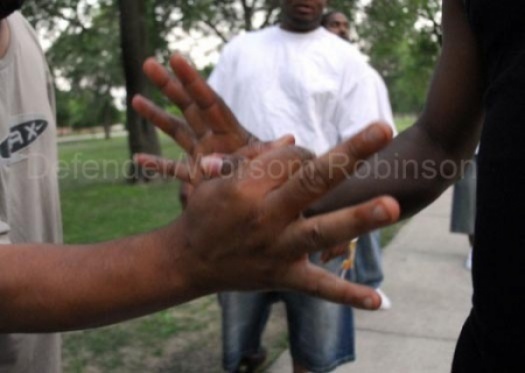
Makeshift memorials of balloons, stuffed animals, flowers and poster boards with written sentiments have been a mainstay along tree-lined and manicured lawn streets of the South and West sides of Chicago this year. Homicides in the city continue on a slig
Makeshift memorials of balloons, stuffed animals, flowers and poster boards with written sentiments have been a mainstay along tree-lined and manicured lawn streets of the South and West sides of Chicago this year.
Homicides in the city continue on a slight incline each month, but this year, there is a slight difference in where the increase is.
In areas where murders were rampant and some were not, the numbers flip-flopped. In some areas, the numbers remained almost the same.
During the first seven months of 2007, the Southeast and Far South Side logged 12 homicides. For the same period this year, it more than doubled–28 homicides.
On the West Side in Lawndale and Garfield Park, there were 29 murders from January to July 2007. For the first seven months of this year, there were six fewer in those areas.
Why the shift?
The dismantling of gang leadership led to smaller clusters vying for control, a spokesperson for the Chicago Police Department said.
In the South Shore, Pullman and Roseland neighborhoods on the South Side, the police disrupted the heads of several gangs that controlled the streets, resulting in different factions breaking off to establish new turf.
But that “success” brought on a new trend that has proven to be challenging for police.
“Once we successfully took down the gang hierarchies, we’ve noticed a new trend. Smaller crews are jockeying for turf. So now we’ve got to adjust our strategies to address this shift,” said police spokesperson Monique Bond.
This summer, several teens on the South Side were gunned down, apparently caught in gang crossfire. In fact, most of the slain were not the intended targets.
Within the last three months, a 14-year-old boy riding his bike in the 11900 block of South Perry Avenue was shot in the head; two teens were shot to death in front of a church in the 7500 block of South Phillips Avenue; and a 15-year-old was felled by gun violence as he sat in his backyard in the 100 block of West 116th Street.
Residents on the Southeast and Far South Sides said they are scared to let their children go outside and do “what kids normally do.”
“It’s a shame to see that kids and adults have to duck bullets and hide in their homes, mainly the basements, to keep from getting shot. No one settles disputes with their hands anymore,” said Willie Edwards, who lives near “Terror Town” on the Southeast Side.
The moniker was adopted decades ago because the small area just south of the South Shore Cultural Center on 70th and South Shore Drive is known for its unbridled violence.
There have been several anti-violence marches on the South Side, most recently in the Roseland and West Pullman communities, also known as the “Wild Hundreds”–traditionally100th Street to 138th Street.
After marchers trekked from 116th and Perry to 119th and Perry, a three-block radius known for gang wars, the area director for the anti-violence organization CeaseFire called on gang members to put their guns down and increase the peace.
“This madness has to stop,” said Bob Jackson of the CeaseFire branch in West Pullman.
Charles Ellis, a resident of Roseland for the last five years, agreed. “The gangs don’t have anything valid to fight about. Not one single gang member owns any land in any area they are in. I feel confident in saying that none of them pay property taxes, yet they want to own the streets,” Ellis said.
“Terror Town” and the “Wild Hundreds” are not the only areas on the South Side with high murder stats this year. Englewood has been consistent with its homicide numbers. From January to July 2007, Englewood had 25 murders, compared to 26 for the same period this year. Among those killed in the area: A 28-year-old man in the 6400 block of South Oakley Boulevard and a 15-year-old who was gunned down after he answered his door.
It’s the same story–gang turf wars–but it’s been going on for longer than what other areas have experienced.
“When I first came to Englewood to look for a place to live, I apparently came on a good day and when evil was sleeping. It was in the morning, and activity was scarce in the area,” said Prince Akbar.
Just a few weeks after he moved in, the scenery changed drastically, he said.
“I heard gunshots just about every night. I was terrified. There was a week in July when it seemed as though everyone in the neighborhood got a memo but me,” Akbar said, referring to a week when adults and children were in their respective homes by dusk.
A few hours later, he realized why. “I could see and hear gangbangers shooting at each other across the street. There was one instance where I had my window open, and I could literally hear guys whispering by my window and hear them reload a 12-gauge shotgun,” he said.
Akbar said that violence was something that he was not accustomed to when he lived on the North Side. He wants to move but doesn’t have the funds to do so. In the meantime, he keeps a daily blog about what he sees and hears in the neighborhood.
“Violence in Englewood is on an Iraq level,” he said, hoping that his chronicling will help shed light on the “war zone” he lives in.
Police said they are ramping up patrols in high crime areas, including utilizing helicopters and arming more police officers with assault-type weapons to mirror the cache the gangs are brandishing. But it’s going to take huge help from the community.
“We can’t do it alone because although the gang factions are smaller and less sophisticated, they are equally dangerous.
Although we successfully took down the heads of many gangs, we have now become a victim of our own success,” Bond said.
In the Garfield Park and Lawndale areas on the West Side, typically known as the “Wild, Wild West Side,” murders have been on a steady decline.
The key factor in that downturn–community involvement, the police First Deputy James Jackson said.
Jackson was the commander of the Harrison District before his appointment earlier this year and saw the homicide numbers shift downward as a result of residents vowing to take their streets back.
“We knew that many people were afraid to come to the (Chicago Alternative Policing Strategy) meetings because some of the criminals sent representatives to find out what was being reported. We took it a step further. We had more officers saturate the blocks and mailboxes with flyers alerting residents to speak directly with officers and talk to their pastors,” Jackson said.
Jackson said sometimes citizens trust the clergy more than the police. The clergy then helped gel the relationship between the police and the community.
That mended relationship formed more block clubs and had more calls coming into the station about wrongdoings in the community. It also increased police presence in sorely needed areas. Homicides then started to decrease, he said.
“We can’t rid the streets of violence without the community’s help,” Jackson added.
From January to July this year, there were 291 homicides. Last year there were a total of 443 homicides in the city, less than half the
record set in 1974–1970, according to Chicago police statistics.

Kathy Chaney can be reached via e-mail at kchaney@chicagodefender.com.
Photo by Defender/Worsom Robinson
Copyright 2008 Chicago Defender. All rights reserved. This material may not be published, broadcast, rewritten, or redistributed.



